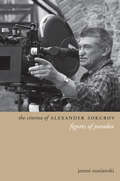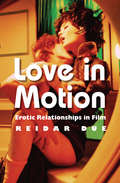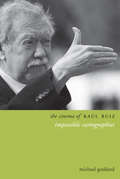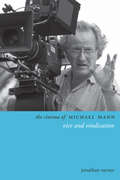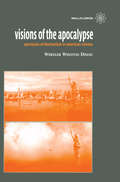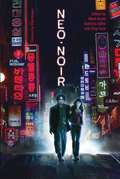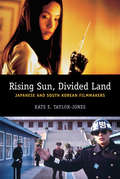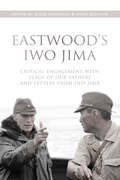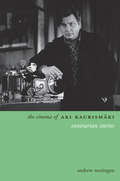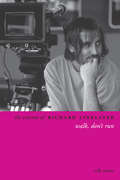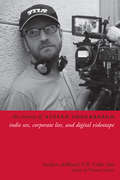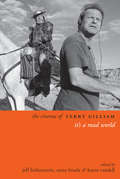- Table View
- List View
The Cinema of Alexander Sokurov: Figures of Paradox
by Jeremi SzaniawskiOne of the last representatives of a brand of serious, high-art cinema, Alexander Sokurov has produced a massive oeuvre exploring issues such as history, power, memory, kinship, death, the human soul, and the responsibility of the artist. Through contextualization and close readings of each of his feature fiction films (broaching many of his documentaries in the process), this volume unearths a vision of Sokurov's films as equally mournful and passionate, intellectual, and sensual, and also identifies in them a powerful, if discursively repressed, queer sensitivity, alongside a pattern of tensions and paradoxes. This book thus offers new keys to understand the lasting and ever-renewed appeal of the Russian director's Janus-like and surprisingly dynamic cinema -- a deeply original and complex body of work in dialogue with the past, the present and the future.
The Cinema of Alexander Sokurov: Figures of Paradox (Directors' Cuts)
by Jeremi SzaniawskiOne of the last representatives of a brand of serious, high-art cinema, Alexander Sokurov has produced a massive oeuvre exploring issues such as history, power, memory, kinship, death, the human soul, and the responsibility of the artist. Through contextualization and close readings of each of his feature fiction films (broaching many of his documentaries in the process), this volume unearths a vision of Sokurov's films as equally mournful and passionate, intellectual, and sensual, and also identifies in them a powerful, if discursively repressed, queer sensitivity, alongside a pattern of tensions and paradoxes. This book thus offers new keys to understand the lasting and ever-renewed appeal of the Russian director's Janus-like and surprisingly dynamic cinema – a deeply original and complex body of work in dialogue with the past, the present and the future.
Love in Motion
by Reidar DueThis is a book about how film encountered love in the course of its history. It is also a book about the philosophy of love. Since Plato, erotic love has been praised for leading the soul to knowledge. The vast tradition of poetry devoted to love has emphasized that love is a feeling. Love in Motion presents a new metaphysics and ontology of love as a reciprocal erotic relationship. The book argues that film has been particularly well suited for depicting love in this way, in virtue of its special narrative language. This is a language of expression that has developed in the course of film history. The book spans this history from early silent directors such as Joseph von Sternberg to contemporary filmmakers like Sophia Coppola. At the centre of this study is a comparison between Classical French and American love films of the forties and a series of modernist films by Luis Buñuel, François Truffaut and Wong Kar Wai.
Love in Motion: Erotic Relationships in Film
by Reidar DueThis is a book about how film encountered love in the course of its history. It is also a book about the philosophy of love. Since Plato, erotic love has been praised for leading the soul to knowledge. The vast tradition of poetry devoted to love has emphasized that love is a feeling. Love in Motion presents a new metaphysics and ontology of love as a reciprocal erotic relationship. The book argues that film has been particularly well suited for depicting love in this way, in virtue of its special narrative language. This is a language of expression that has developed in the course of film history. The book spans this history from early silent directors such as Joseph von Sternberg to contemporary filmmakers like Sophia Coppola. At the centre of this study is a comparison between Classical French and American love films of the forties and a series of modernist films by Luis Buñuel, François Truffaut and Wong Kar Wai.
The Cinema of Raul Ruiz
by Michael GoddardRaúl Ruiz, while considered one of the world's most significant filmmakers by several film critics, is yet to be the subject of any thorough engagement with his work in English. This volume sets out on this task by mapping, as fully as possible, Ruiz's cinematic trajectory across more than five decades of prolific work, up to his death in 2011; ranging from his earliest work in Chile to high-budget 'European' costume dramas culminating in Mysteries of Lisbon (2010). It does so by treating Ruiz's work -- with its surrealist, magic realist, popular cultural, and neo-Baroque sources -- as a type of 'impossible' cinematic cartography, mapping real, imaginary, and virtual spaces, and crossing between different cultural contexts, aesthetic strategies, and technical media. It argues that across the different phases of Ruiz's work identified, there are key continuities such as the invention of singular cinematic images and the interrogation of their possible and impossible combinations.
The Cinema of Raúl Ruiz: Impossible Cartographies (Directors' Cuts)
by Michael GoddardRaúl Ruiz, while considered one of the world's most significant filmmakers by several film critics, is yet to be the subject of any thorough engagement with his work in English. This volume sets out on this task by mapping, as fully as possible, Ruiz's cinematic trajectory across more than five decades of prolific work, up to his death in 2011; ranging from his earliest work in Chile to high-budget 'European' costume dramas culminating in Mysteries of Lisbon (2010). It does so by treating Ruiz's work—with its surrealist, magic realist, popular cultural, and neo-Baroque sources—as a type of 'impossible' cinematic cartography, mapping real, imaginary, and virtual spaces, and crossing between different cultural contexts, aesthetic strategies, and technical media. It argues that across the different phases of Ruiz's work identified, there are key continuities such as the invention of singular cinematic images and the interrogation of their possible and impossible combinations.
The Cinema of Michael Mann
by Jonathan RaynerMichael Mann is one of the most important American filmmakers of the past forty years. His films exhibit the existential concerns of art cinema, articulated through a conspicuous and recognizable visual style and yet integrated within classical Hollywood narrative and genre frameworks. Since his beginnings as a screenwriter in the 1970s, Mann has become a key figure within contemporary American popular culture as writer, director, and producer for film and television. This volume offers a detailed study of Mann's feature films, from The Jericho Mile (1979) to Public Enemies (2009), with consideration also being given to parallels in the production, style, and characterization in his television work. It explores Mann's relationship with classical genres, his thematic concentration on issues of morality and masculinity, his film adaptations from literature, and the development and significance of his trademark visual style within modern American cinema.
The Cinema of Michael Mann: Vice and Vindication (Directors' Cuts)
by Jonathan RaynerMichael Mann is one of the most important American filmmakers of the past forty years. His films exhibit the existential concerns of art cinema, articulated through a conspicuous and recognizable visual style and yet integrated within classical Hollywood narrative and genre frameworks. Since his beginnings as a screenwriter in the 1970s, Mann has become a key figure within contemporary American popular culture as writer, director, and producer for film and television. This volume offers a detailed study of Mann's feature films, from The Jericho Mile (1979) to Public Enemies (2009), with consideration also being given to parallels in the production, style, and characterization in his television work. It explores Mann's relationship with classical genres, his thematic concentration on issues of morality and masculinity, his film adaptations from literature, and the development and significance of his trademark visual style within modern American cinema.
Visions of the Apocalypse: Spectacles of Destruction in American Cinema
by Dixon Wheeler WinstonVisions of the Apocalypse examines the cinema's fascination with the prospect of nuclear and/or natural annihilation, as seen in such films as Saving Private Ryan, Bowling for Columbine, We Were Soldiers, Invasion U.S.A., The Last War, Tidal Wave, The Bed Sitting Room, The Last Days of Man on Earth and numerous others. It also considers the ways in which contemporary cinema has become increasingly hyper-conglomerised, leading to films with ever-higher budgets and fewer creative risks. Along the way, the author discusses such topics as the death of film itself, to be replaced by digital video; the political and social tensions that have made these visions of infinite destruction so appealing to the public; and the new wave of Hollywood war films, coupled with escapist comedies, in the post-9/11 era. Encompassing both questions of physical and filmic mortality Visions of the Apocalypse is a meditation on the questions of time, memory and the cinema's seemingly unending appetite for spectacles of destruction.
Visions of the Apocalypse: Spectacles of Destruction in American Cinema
by Dixon Wheeler WinstonVisions of the Apocalypse examines the cinema's fascination with the prospect of nuclear and/or natural annihilation, as seen in such films as Saving Private Ryan, Bowling for Columbine, We Were Soldiers, Invasion U.S.A., The Last War, Tidal Wave, The Bed Sitting Room, The Last Days of Man on Earth and numerous others. It also considers the ways in which contemporary cinema has become increasingly hyper-conglomerised, leading to films with ever-higher budgets and fewer creative risks. Along the way, the author discusses such topics as the death of film itself, to be replaced by digital video; the political and social tensions that have made these visions of infinite destruction so appealing to the public; and the new wave of Hollywood war films, coupled with escapist comedies, in the post-9/11 era. Encompassing both questions of physical and filmic mortality Visions of the Apocalypse is a meditation on the questions of time, memory and the cinema's seemingly unending appetite for spectacles of destruction.
Visions of the Apocalypse: Spectacles of Destruction in American Cinema (Film Studies)
by Wheeler Winston DixonVisions of the Apocalypse examines the cinema's fascination with the prospect of nuclear and/or natural annihilation, as seen in such films as Saving Private Ryan, Bowling for Columbine, We Were Soldiers, Invasion U.S.A., The Last War, Tidal Wave, The Bed Sitting Room, The Last Days of Man on Earth and numerous others. It also considers the ways in which contemporary cinema has become increasingly hyper-conglomerised, leading to films with ever-higher budgets and fewer creative risks. Along the way, the author discusses such topics as the death of film itself, to be replaced by digital video; the political and social tensions that have made these visions of infinite destruction so appealing to the public; and the new wave of Hollywood war films, coupled with escapist comedies, in the post-9/11 era. Encompassing both questions of physical and filmic mortality Visions of the Apocalypse is a meditation on the questions of time, memory and the cinema's seemingly unending appetite for spectacles of destruction.
Neo-Noir (Wallflower Press #PPCS)
by Mark Bould Greg Tuck Kathrina GlitreNeo-noir knows its past. It knows the rules of the game – and how to break them. From Point Blank (1998) to Oldboy (2003), from Get Carter (2000) to 36 Quai des Orfèvres (2004), from Catherine Tramell to Max Payne, neo-noir is a transnational global phenomenon. This wide-ranging collection maps out the terrain, combining genre, stylistic and textual analysis with Marxist, feminist, psychoanalytic and industrial approaches. Essays discuss works from the US, UK, France, Japan, South Korea, Hong Kong and New Zealand; key figures, such as David Lynch, the Coen Brothers, Quentin Tarantino and Sharon Stone; major conventions, such as the femme fatale, paranoia, anxiety, the city and the threat to the self; and the use of sound and colour.
Rising Sun, Divided Land: Japanese and South Korean Filmmakers
by Kate Taylor-JonesRising Sun and Divided Land provides a comprehensive, scholarly examination of the historical background, films, and careers of selected Korean and Japanese film directors. It examines eight directors: Fukasaku Kinji, Im Kwon-teak, Kawase Naomi, Miike Takashi, Lee Chang-dong, Kitano Takeshi, Park Chan-wook, and Kim Ki-duk and considers their work as reflections of personal visions and as films that engage with globalization, colonialism, nationalism, race, gender, history, and the contemporary state of Japan and South Korea. Each chapter is followed by a short analysis of a selected film, and the volume as a whole includes a cinematic overview of Japan and South Korea and a list of suggestions for further reading and viewing.
Eastwood's Iwo Jima
by Rikke Schubart Anne GjelsvikWith Flags of Our Fathers (2006) and Letters from Iwo Jima (2006), Clint Eastwood made a unique contribution to film history, being the first director to make two films about the same event. Eastwood's films examine the battle over Iwo Jima from two nations' perspectives, in two languages, and embody a passionate view on conflict, enemies, and heroes. Together these works tell the story behind one of history's most famous photographs, Leo Rosenthal's "Raising the Flag on Iwo Jima." In this volume, international scholars in political science and film, literary, and cultural studies undertake multifaceted investigations into how Eastwood's diptych reflects war today. Fifteen essays explore the intersection among war films, American history, and Japanese patriotism. They present global attitudes toward war memories, icons, and heroism while offering new perspectives on cinema, photography, journalism, ethics, propaganda, war strategy, leadership, and the war on terror.
Eastwood's Iwo Jima: Critical Engagements with Flags of Our Fathers and Letters from Iwo Jima
by Rikke Schubart Eds. Gjelsvik AnneWith Flags of Our Fathers (2006) and Letters from Iwo Jima (2006), Clint Eastwood made a unique contribution to film history, being the first director to make two films about the same event. Eastwood's films examine the battle over Iwo Jima from two nations' perspectives, in two languages, and embody a passionate view on conflict, enemies, and heroes. Together these works tell the story behind one of history's most famous photographs, Leo Rosenthal's "Raising the Flag on Iwo Jima." In this volume, international scholars in political science and film, literary, and cultural studies undertake multifaceted investigations into how Eastwood's diptych reflects war today. Fifteen essays explore the intersection among war films, American history, and Japanese patriotism. They present global attitudes toward war memories, icons, and heroism while offering new perspectives on cinema, photography, journalism, ethics, propaganda, war strategy, leadership, and the war on terror.
Film Dialogue
by Jeff JaeckleFilm Dialogue is the first anthology in film studies devoted to the topic of language in cinema, bringing together leading and emerging scholars to discuss the aesthetic, narrative, and ideological dimensions of film speech.
Film Dialogue
by Ed. Jeff JaeckleFilm Dialogue is the first anthology in film studies devoted to the topic of language in cinema, bringing together leading and emerging scholars to discuss the aesthetic, narrative, and ideological dimensions of film speech that have largely gone unappreciated and unheard. Consisting of thirteen essays divided into three sections: genre, auteur theory, and cultural representation, Film Dialogue revisits and reconfigures several of the most established topics in film studies in an effort to persuade readers that "spectators" are more accurately described as "audiences," that the gaze has its equal in eavesdropping, and that images are best understood and appreciated through their interactions with words. Including an introduction that outlines a methodology of film dialogue study and adopting an accessible prose style throughout, Film Dialogue is a welcome addition to ongoing debates about the place, value, and purpose of language in cinema.
The Cinema of Aki Kaurismäki: Contrarian Stories
by Andrew NestingenAki Kaurismäki is an enigma, an eminent auteur who claims his films are a joke. Since 1983, Kaurismäki has produced classically-styled films filled with cinephilic references to film history. He has earned an international art-house audience and many prizes, influencing such directors as Jim Jarmusch, Quentin Tarantino, and Wes Anderson. Yet Kaurismäki is often depicted as the loneliest, most nostalgic of Finns (except when he promotes his films, makes political statements, and runs his many businesses). He is also depicted as a bohemian known for outlandish actions and statements. The Cinema of Aki Kaurismäki is the first comprehensive English-language study of this eccentric director. Drawing on revisionist approaches to film authorship, the text links the filmmaker and his films to the stories and issues animating film aesthetics and history, nostalgia, late modernity, politics, commerce, film festivals, and national cinema.
The Cinema of Aki Kaurismäki: Contrarian Stories (Directors' Cuts)
by Andrew NestingenAki Kaurismäki is an enigma, an eminent auteur who claims his films are a joke. Since 1983, Kaurismäki has produced classically-styled films filled with cinephilic references to film history. He has earned an international art-house audience and many prizes, influencing such directors as Jim Jarmusch, Quentin Tarantino, and Wes Anderson. Yet Kaurismäki is often depicted as the loneliest, most nostalgic of Finns (except when he promotes his films, makes political statements, and runs his many businesses). He is also depicted as a bohemian known for outlandish actions and statements. The Cinema of Aki Kaurismäki is the first comprehensive English-language study of this eccentric director. Drawing on revisionist approaches to film authorship, the text links the filmmaker and his films to the stories and issues animating film aesthetics and history, nostalgia, late modernity, politics, commerce, film festivals, and national cinema.
The Cinema of Richard Linklater: Walk, Don't Run
by Rob StoneFrom Slacker (1991) to The School of Rock (2003), from Before Sunrise (1995) to Before Sunset (2004), from the walking and talking of his no/low-budget American independent films to conversing with the philosophical traditions of the European art house, Richard Linklater's films are some of the most critical, political, and spiritual achievements of contemporary world cinema. Examinations of Linklater's collaborative working practices and deployment of rotoscoping and innovative distribution strategies all feature in this book, which aspires to walk and talk with the filmmaker and his films. Informed by a series of original interviews with the artist, in both his hometown and frequent film location of Austin, Texas, this study of the director who made Dazed and Confused (1993), A Scanner Darkly (2006), and Bernie (2011) explores the theoretical, practical, contextual, and metaphysical elements of these works along with his documentaries and side-projects and finds fanciful lives and lucid dreams have as much to do with his work as generally alternative notions of America, contemporary society, cinema, and time.
The Cinema of Richard Linklater: Walk, Don't Run (Directors' Cuts)
by Rob StoneFrom Slacker (1991) to The School of Rock (2003), from Before Sunrise (1995) to Before Sunset (2004), from the walking and talking of his no/low-budget American independent films to conversing with the philosophical traditions of the European art house, Richard Linklater's films are some of the most critical, political, and spiritual achievements of contemporary world cinema. Examinations of Linklater's collaborative working practices and deployment of rotoscoping and innovative distribution strategies all feature in this book, which aspires to walk and talk with the filmmaker and his films. Informed by a series of original interviews with the artist, in both his hometown and frequent film location of Austin, Texas, this study of the director who made Dazed and Confused (1993), A Scanner Darkly (2006), and Bernie (2011) explores the theoretical, practical, contextual, and metaphysical elements of these works along with his documentaries and side-projects and finds fanciful lives and lucid dreams have as much to do with his work as generally alternative notions of America, contemporary society, cinema, and time.Â
The Cinema of Steven Soderbergh: Indie Sex, Corporate Lies, and Digital Videotape
by Dewaard Andrew R. Colin TaitThe industry's only director-cinematographer-screenwriter-producer-actor-editor, Steven Soderbergh is contemporary Hollywood's most innovative and prolific filmmaker. A Palme d'or and Academy Award-winner, Soderbergh has directed nearly thirty films, including political provocations, digital experiments, esoteric documentaries, global blockbusters, and a series of atypical genre films. This volume considers its slippery subject from several perspectives, analyzing Soderbergh as an expressive auteur of art cinema and genre fare, as a politically-motivated guerrilla filmmaker, and as a Hollywood insider. Combining a detective's approach to investigating the truth with a criminal's alternative value system, Soderbergh's films tackle social justice in a corporate world, embodying dozens of cinematic trends and forms advanced in the past twenty-five years. His career demonstrates the richness of contemporary American cinema, and this study gives his complex oeuvre the in-depth analysis it deserves.
The Cinema of Steven Soderbergh: Indie Sex, Corporate Lies, and Digital Videotape (Directors' Cuts)
by R. Colin Tait Andrew deWaardThe industry's only director-cinematographer-screenwriter-producer-actor-editor, Steven Soderbergh is contemporary Hollywood's most innovative and prolific filmmaker. A Palme d'or and Academy Award-winner, Soderbergh has directed nearly thirty films, including political provocations, digital experiments, esoteric documentaries, global blockbusters, and a series of atypical genre films. This volume considers its slippery subject from several perspectives, analyzing Soderbergh as an expressive auteur of art cinema and genre fare, as a politically-motivated guerrilla filmmaker, and as a Hollywood insider. Combining a detective's approach to investigating the truth with a criminal's alternative value system, Soderbergh's films tackle social justice in a corporate world, embodying dozens of cinematic trends and forms advanced in the past twenty-five years. His career demonstrates the richness of contemporary American cinema, and this study gives his complex oeuvre the in-depth analysis it deserves.
The Cinema of Terry Gilliam: It's a Mad World
by Jeff Birkenstein Anna Froula Karen RandellTerry Gilliam has been making movies for more than forty years, and this volume analyzes a selection of his thrilling directorial work, from his early films with Monty Python to The Imaginarium of Doctor Parnussus (2009). The frenetic genius, auteur, and social critic continues to create indelible images on screen--if, that is, he can get funding for his next project. Featuring eleven original essays from an international group of scholars, this collection argues that when Gilliam makes a movie, he goes to war: against Hollywood caution and convention, against American hyper-consumerism and imperial militarism, against narrative vapidity and spoon-fed mediocrity, and against the brutalizing notion and cruel vision of the "American Dream."
The Cinema of Terry Gilliam: It's a Mad World (Directors' Cuts)
by Jeff Birkenstein Anna Froula Karen Randell Eds.Terry Gilliam has been making movies for more than forty years, and this volume analyzes a selection of his thrilling directorial work, from his early films with Monty Python to The Imaginarium of Doctor Parnussus (2009). The frenetic genius, auteur, and social critic continues to create indelible images on screen--if, that is, he can get funding for his next project. Featuring eleven original essays from an international group of scholars, this collection argues that when Gilliam makes a movie, he goes to war: against Hollywood caution and convention, against American hyper-consumerism and imperial militarism, against narrative vapidity and spoon-fed mediocrity, and against the brutalizing notion and cruel vision of the "American Dream."
